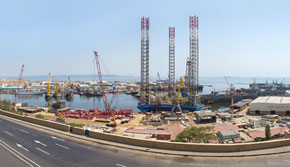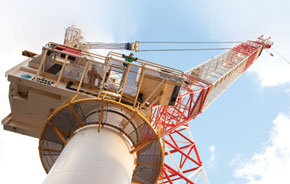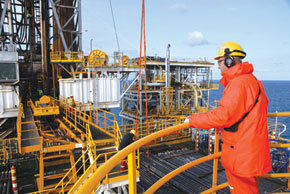Twenty years ago Azerbaijan signed the ‘Contract of the Century’ with a consortium of international oil companies to develop the offshore Azeri-Chiraq-Guneshli (ACG) fields. Ten years ago work started on the Baku-Tbilisi-Ceyhan pipeline to export ACG oil. Now, Azerbaijan has taken on the Southern Corridor gas project, another game-changer in the country’s energy industry.
The view from the observation terrace at Bibiheybet Mosque, just south of Baku, encompasses almost every aspect of today’s oil and gas sector. Nodding donkeys pump out oil along the seashore, vessels serving the offshore industry are repaired in the small bay below the mosque, a little further away the new building for the State Oil Company (SOCAR) Oil Academy is under construction and work is in full swing at the ATA (Azfen-Tekfen-Amec) Shipyard. The fruit of years of hard work by SOCAR’s Environmental Department is also in evidence. Much of the oil-polluted land has been reclaimed and even planted with shrubs and trees. Gone are many of the derricks through which James Bond drove in The World is Not Enough. Even the oil lakes that disfigured this part of the Caspian coast for over a century have disappeared.
The ATA Shipyard merits a closer look. It has won one of the largest contracts, worth nearly one billion dollars, within Stage 2 of the project to develop the giant Shah Deniz gas field. The Azerbaijani-Turkish-British consortium will build the complex topside units for the production platform and the residential platform at the Bibiheybet shipyard. Under past contracts, modular components were made abroad and assembled in Baku. This time, however, manufacture and assembly will both be done in Azerbaijan. High quality metal for the platforms has already been delivered. Over the coming year the number of workers on the platform will increase to 4,750, some 90% of whom will be local staff.
Ten years ago
Ten years ago, the major project in the Azerbaijani energy industry was construction of the Baku-Tbilisi-Ceyhan oil pipeline. The BTC Company was formed in 2003, while construction of the 1,768-km pipeline began the following year. The construction contract had been signed earlier, in 1999. Despite the support of Western countries, in particular, Washington and the EU, problems remained with financing. Many companies doubted the commercial viability of such a long pipeline that had to connect two seas – the Caspian and Mediterranean. Even majors such as Exxon Mobil refused to join the BTC shareholders. International NGO and human rights organisations picketed financial organisations when talks on credits for BTC were under way, calling for the project not to be financed on the grounds that "oil is suppression of democracy, freedom of expression” and of damage to Caspian flora and fauna. Despite the problems and the delays over environmental concerns in Georgia’s Borjomi valley, the project was completed.
Azerbaijan and its oil partners had kept faith with development of the oil industry. Indeed, the AIOC, the consortium developing the Azeri-Chiraq-Guneshli bloc, had gone ahead with full-field development without any guarantees that BTC would be built. The figures given below show that faith was not misplaced.
New ‘energy game’
Azerbaijan is in a similar situation to ten years ago, but now the scale of geopolitical influence on the country’s projects is far greater and potentially more threatening. I say ‘threatening’ because of the collision of interests of the West and Russia in a new ‘energy game’, in which Azerbaijani gas is given special preference in the diversification of energy supplies to Europe and reduction of the continent’s dependence on Russian gas.
Azerbaijan is interested in becoming a reliable energy partner for Europe, hence its enthusiasm for the Southern Corridor, the route for the supply of Caspian gas via Georgia, Turkey, Greece and Albania to Italy. At the same time, as the SOCAR vice-president for investments and marketing, Elshad Nasirov, said recently in an interview with CNN: Azerbaijani gas isn't considered a big competitor to Russian gas in the European market, as at the initial stage volumes of gas supplies from Azerbaijan to Europe will not be considerable. He added that Azerbaijan now exports most of its gas to neighbouring countries – Georgia, Russia and Turkey.
However, two developments involving Russia mean that Brussels has started to pin more hopes on Azerbaijan. After ten years of talks, Moscow has signed a 30-year contract with Beijing for the export of gas via the ‘Power of Siberia’ pipeline, diversifying its gas exports for practically the first time. Meanwhile, the mega South Stream pipeline, envisaging the export of 63 billion cubic metres of Russian gas across the Black Sea to Europe by 2018, bypassing Ukraine, has hit a snag. Construction has been suspended in Bulgaria and Serbia while Brussels investigates Gazprom’s failure to observe EU energy legislation.
Azerbaijan is the only alternative market able to organise the export of gas via pipeline to the EU within the next five years. Moreover, Azerbaijan has the capacity to gradually increase export volumes.
On 19 September 2013, a ceremony was held in Baku to mark the signing of purchase agreements for Shah Deniz-2 gas with nine companies for 25 years, beginning in 2019. The companies are Shell, Bulgar Gas, DEPA, Gas Natural Fenosa, E.ON, Gaz de France, Hera, Enel and AXPO.
However, speaking at the Caspian Oil & Gas 2014 conference in Baku, SOCAR President Rovnaq Abdullayev said that the company plans to start construction of the Trans Anatolian Gas Pipeline (TANAP) at the end of the year and to complete it by 2018. The pipeline will have a throughput capacity of 16 billion cubic metres per annum. He said that the pipeline’s design allows for gradual expansion by increasing the capacity of the pump and compressor stations. The second stage of expansion of the pipeline is planned for 2023, while by 2026 the throughput capacity of TANAP will be brought up to its maximum of 31 billion cubic metres per annum.
Both the South Caucasus and TANAP pipelines are designed to pump a maximum of 31 billion cubic metres, while the TAP pipeline will be able to take 20 billion per annum. In other words, by the middle of the next decade Azerbaijan will have the real possibility of finding new markets for its gas in Europe, exported via new infrastructure.
Technical challenges
This is the situation in which Azerbaijan and its partners will not only begin gas production from technically challenging depths beneath the Caspian, but also lay some 4,000 kilometres of pipeline and accompanying infrastructure to ensure the uninterrupted, stable supply of natural gas to the European Union. This will be no easy task, considering that the gas deposits lie in strata 6,800-7,100 metres below the seabed. The sea, meanwhile, is 550 metres deep.
Therefore, some of the most advanced technology will be used for the first time on the Caspian as part of Shah Deniz-2. The production platform, which will be mounted at sea, will have no drilling rig and tower as we are used to seeing. Wells will instead be drilled in several locations by floating drilling rigs to productive layers and then closed. Shah Deniz will have a subsea production system consisting of 500 kilometres of flowlines connecting 10 subsea manifolds and 26 subsea wells. The gas and gas condensate will be pumped to the terminal at Sangachal, south-west of Baku. To avoid problems caused by the cold, deepwater electrical heating will keep the pipelines warm.
These facts and figures show the sheer size and complexity of Shah Deniz-2. Moreover, the project will create some 16,000 jobs in Azerbaijan, another first in terms of scale.
Responsibility
Over the past ten years, Europe heard intermittently about the giant Nabucco pipeline project, which was to have the capacity to supply 31 billion cubic metres of natural gas to European markets from alternative sources. But Europe from the beginning blew hot and cold on the project, then because of the financial crisis did not have the resources for it and made no commercially attractive bids to carry out Nabucco.
As a result, the expanded Southern Caucasus pipeline through Azerbaijan and Georgia, the Trans Anatolian Pipeline through Turkey and the Trans-Adriatic Pipeline through Greece and Albania to Italy today fulfil the purpose that the Nabucco shareholders dreamt of and Europe wanted. The only difference is that the burden of this mission is assumed by Azerbaijan, Turkey and the Shah Deniz shareholders. So Europe should appreciate Azerbaijan’s contribution and the risk it is taking for its energy security.
Facts and figures
Baku-Tbilisi-Ceyhan has already exported more than 255 million tonnes of oil, 244.6 million tonnes of which is Azerbaijani oil
By the end of this year, 70 per cent of the loans to finance BTC will have been repaid As well as Azerbaijani oil, BTC transports Turkmen, Kazakh and Russian oil (the Russian oil is exported via Lukoil from the Filanovsky deposit in the Caspian)
Between November 1997 and 1 May 2014, 177 million of the 333.6 million tonnes of oil extracted as part of the Azeri-Chiraq-Guneshli project was profit oil, in other words the revenue from it went straight to the state. In 2013, revenue from the sale of 22.5 million of 32.7 million tonnes of oil produced at ACG was accumulated in the State Oil Fund
The Oil Fund has already received more than 100 billion dollars in profit from ACG By 2025, Azerbaijan’s revenues from Azeri-Chiraq-Guneshli are forecast to reach 230-240 billion dollars
About the author: Ilham Shaban is head of the Caspian Barrel Oil Research Centre.





